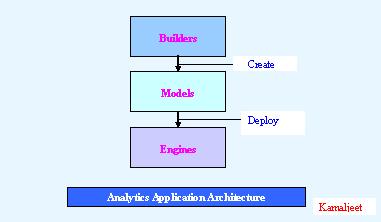In sequence to the past weblogs written by me in the domain of data mining, this one takes a step ahead in terms of some applications in which analytics are being used.
The ideal scenario for Analytical applications comes under the area of CRM (Customer Relationship Management), SCM (Supply Chain Management), and Financials.
CRM supports marketing, selling, and customer service.
SCM supports sourcing, making, logistics and delivering products.
Financials is used to tie all the enterprise wide pieces together for consolidation, financial analysis, planning and simulation, strategy management, corporate performance measurement, and stakeholder relationship management.
Analytics Application Architecture: 
Builders: These are tools that allow us to build the analytic application environment. The Administrator Workbench, the Data Mining Workbench, and the SEM Planning Environment are examples of builders for analytic applications.
Models: These are designs that are either standard-delivered or custom-developed. Business Content and its information models play a major role here.
Engines: These represent the application-specific logic that has to be applied during run time. OLAP, data mining, and planning calculations are performed by their respective engines.
For creation of Analytics Applications we use technological components available with SAP like SAP CRM, SAP APO (Advance Planner and Optimizer), and SAP SEM (Strategic Enterprise Management) They all interact with ASP BW, but in a different way. The builders, models, and engines for CRM analytics come pre-delivered as part of Business Content with SAP BW. In contrast, the builders, models, and engines for SAP APO are not in SAP BW. Instead, they are built directly into the SAP APO application, while the SAP BW itself is directly embedded into SAP APO as part of a merged environment. The builders, models, and engines for SAP SEM come as an add-on application directly on top of SAP BW.
Below are some examples of Analytics Application for SAP BI:
- Customer Relationship Analytics
- Customer Behavior Analysis
- Customer Lifetime Value Analysis
- RFM (recency, frequency, and monetary) Analysis
- Supply Chain Analytics
- SCOR (Supply-Chain Operations Reference) Model
- Supply Chain Cockpit
- Demand Planning
- Strategic Enterprise Management Analytics
- Corporate Performance Management
- Enterprise Planning
- Planning Applications
- Capital Market Interpreter
- Consolidation
Conclusion: Thus we have seen in this web log the major building blocks for analytic application development. The business logic for the engine comes from the normal operational processes and the information required from the data, the models actually designed depending on the scenario and the structure of the application required and the builders are the tools using which this application is designed. Today, with more and more emphasis on dissemination of data to obtain meaningful and valid information, these tools are gaining vast amounts of importance and usage.
